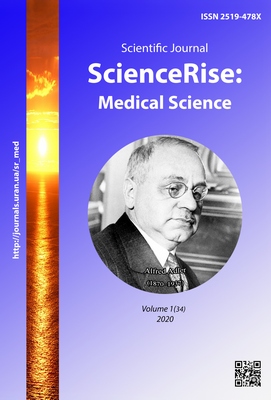Risk factors and prevention of postmastectomic syndrome in breast cancer surgery
DOI:
https://doi.org/10.15587/2519-4798.2020.193288Keywords:
breast cancer, radical surgery, postoperative edema, postmastectomy syndrome, risk factors, preventionAbstract
Postmastectomy syndrome (PMES) is considered one of the most frequent complications after radical operations in patients with breast cancer (BC).
The aim of the study was to identify risk factors and develop preventive measures for PMES after radical operations in BC patients.
Materials and methods. The immediate results of surgical treatment of 147 women with BC who underwent radical surgery were analyzed: the frequency of postoperative edema and PMES depending on the initial clinical and pathological parameters and treatment features using descriptive statistics, χ2 criterion, and correlation analysis.
Results. PMES during the observation period was diagnosed in 17 (11.6 %) patients, including: I st. – in 7 (4.8 %); II st. – in 9 (6.1 %) and III st. in one case (0.7 %). In most cases, its development was associated with postoperative edema, which was detected in the early postoperative period in 15 (88 %) of these patients. The dependence of the incidence of PMES on BMI and the age of patients with a tendency to increase it with the use of adjuvant radiation therapy and decrease with primary breast plastic surgery has been established. The use of a complex of preventive measures led to a decrease in the frequency of PMES (from 17 % to 2 %).
Conclusions. In patients with BC, a frequent complication of radical surgery is postoperative edema of the upper limb and / or PMES, the risk of which increases with increasing age and BMI, as well as with the use of adjuvant radiation therapy. The use of a complex of preventive measures helps to significantly reduce the frequency of these complications
References
- Senkus, E., Kyriakides, S., Ohno, S., Penault-Llorca, F., Poortmans, P., Rutgers, E. et. al. (2015). Primary breast cancer: ESMO Clinical Practice Guidelines for diagnosis, treatment and follow-up. Annals of Oncology, 26, v8–v30. doi: http://doi.org/10.1093/annonc/mdv298
- Rebegea, L., Firescu, D., Dumitru, M., Anghel, R. (2015). The incidence and risk factors for occurrence of arm lymphedema after treatment of breast cancer. Chirurgia (Bucur), 110 (1), 33–37.
- Josephine, D. S. P. (2019). Evaluation of Lymphedema Prevention Protocol on Quality of Life among Breast Cancer Patients with Mastectomy. Asian Pacific Journal of Cancer Prevention, 20 (10), 3077–3084. doi: http://doi.org/10.31557/apjcp.2019.20.10.3077
- Taghian, N. R., Miller, C. L., Jammallo, L. S., O’Toole, J., Skolny, M. N. (2014). Lymphedema following breast cancer treatment and impact on quality of life: A review. Critical Reviews in Oncology/Hematology, 92 (3), 227–234. doi: http://doi.org/10.1016/j.critrevonc.2014.06.004
- Sayegh, H. E., Asdourian, M. S., Swaroop, M. N., Brunelle, C. L., Skolny, M. N., Salama, L., Taghian, A. G. (2017). Diagnostic Methods, Risk Factors, Prevention, and Management of Breast Cancer-Related Lymphedema: Past, Present, and Future Directions. Current Breast Cancer Reports, 9 (2), 111–121. doi: http://doi.org/10.1007/s12609-017-0237-8
- Zou, L., Liu, F., Shen, P., Hu, Y., Liu, X., Xu, Y. et. al. (2018). The incidence and risk factors of related lymphedema for breast cancer survivors post-operation: a 2-year follow-up prospective cohort study. Breast Cancer, 25 (3), 309–314. doi: http://doi.org/10.1007/s12282-018-0830-3
- Gradalski, T., Ochalek, K., Kurpiewska, J. (2015). Complex Decongestive Lymphatic Therapy With or Without Vodder II Manual Lymph Drainage in More Severe Chronic Postmastectomy Upper Limb Lymphedema: A Randomized Noninferiority Prospective Study. Journal of Pain and Symptom Management, 50 (6), 750–757. doi: http://doi.org/10.1016/j.jpainsymman.2015.06.017
- Sagen, A., Kaaresen, R., Sandvik, L., Thune, I., Risberg, M. A. (2014). Upper Limb Physical Function and Adverse Effects After Breast Cancer Surgery: A Prospective 2.5-Year Follow-Up Study and Preoperative Measures. Archives of Physical Medicine and Rehabilitation, 95 (5), 875–881. doi: http://doi.org/10.1016/j.apmr.2013.12.015
- Abass, M. O., Gismalla, M. D. A., Alsheikh, A. A., Elhassan, M. M. A. (2018). Axillary Lymph Node Dissection for Breast Cancer: Efficacy and Complication in Developing Countries. Journal of Global Oncology, 4, 1–8. doi: http://doi.org/10.1200/jgo.18.00080
- Duyur Cakıt, B., Pervane Vural, S., Ayhan, F. F. (2019). Complex Decongestive Therapy in Breast Cancer-Related Lymphedema: Does Obesity Affect the Outcome Negatively? Lymphatic Research and Biology, 17 (1), 45–50. doi: http://doi.org/10.1089/lrb.2017.0086
- McLaughlin, S. A., Wright, M. J., Morris, K. T., Giron, G. L., Sampson, M. R., Brockway, J. P. et. al. (2008). Prevalence of Lymphedema in Women With Breast Cancer 5 Years After Sentinel Lymph Node Biopsy or Axillary Dissection: Objective Measurements. Journal of Clinical Oncology, 26 (32), 5213–5219. doi: http://doi.org/10.1200/jco.2008.16.3725
- Nguyen, T. T., Hoskin, T. L., Habermann, E. B., Cheville, A. L., Boughey, J. C. (2017). Breast Cancer-Related Lymphedema Risk is Related to Multidisciplinary Treatment and Not Surgery Alone: Results from a Large Cohort Study. Annals of Surgical Oncology, 24 (10), 2972–2980. doi: http://doi.org/10.1245/s10434-017-5960-x
Downloads
Published
How to Cite
Issue
Section
License
Copyright (c) 2020 Yuriy Vinnyk, Vadim Vlasenko, Anna Baranova

This work is licensed under a Creative Commons Attribution 4.0 International License.
Our journal abides by the Creative Commons CC BY copyright rights and permissions for open access journals.
Authors, who are published in this journal, agree to the following conditions:
1. The authors reserve the right to authorship of the work and pass the first publication right of this work to the journal under the terms of a Creative Commons CC BY, which allows others to freely distribute the published research with the obligatory reference to the authors of the original work and the first publication of the work in this journal.
2. The authors have the right to conclude separate supplement agreements that relate to non-exclusive work distribution in the form in which it has been published by the journal (for example, to upload the work to the online storage of the journal or publish it as part of a monograph), provided that the reference to the first publication of the work in this journal is included.









